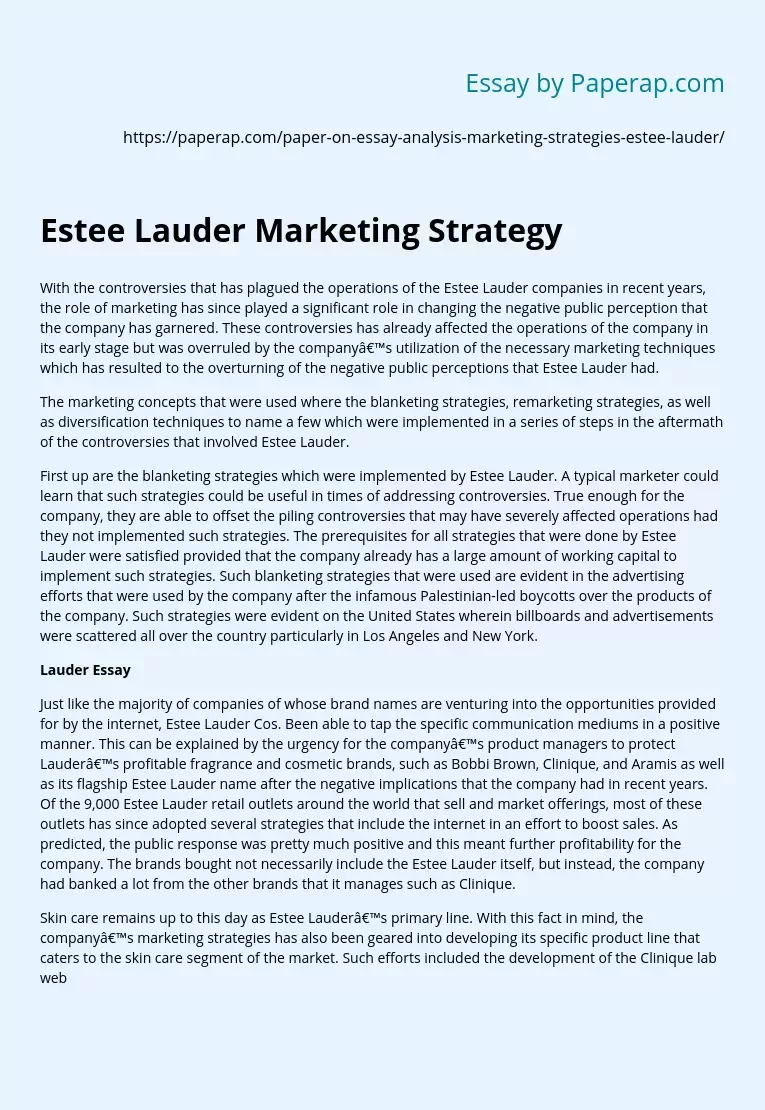Estee Lauder Marketing Strategy
With the controversies that has plagued the operations of the Estee Lauder companies in recent years, the role of marketing has since played a significant role in changing the negative public perception that the company has garnered. These controversies has already affected the operations of the company in its early stage but was overruled by the company’s utilization of the necessary marketing techniques which has resulted to the overturning of the negative public perceptions that Estee Lauder had.
The marketing concepts that were used where the blanketing strategies, remarketing strategies, as well as diversification techniques to name a few which were implemented in a series of steps in the aftermath of the controversies that involved Estee Lauder.
First up are the blanketing strategies which were implemented by Estee Lauder. A typical marketer could learn that such strategies could be useful in times of addressing controversies. True enough for the company, they are able to offset the piling controversies that may have severely affected operations had they not implemented such strategies.
The prerequisites for all strategies that were done by Estee Lauder were satisfied provided that the company already has a large amount of working capital to implement such strategies. Such blanketing strategies that were used are evident in the advertising efforts that were used by the company after the infamous Palestinian-led boycotts over the products of the company. Such strategies were evident on the United States wherein billboards and advertisements were scattered all over the country particularly in Los Angeles and New York.
Lauder Essay
Just like the majority of companies of whose brand names are venturing into the opportunities provided for by the internet, Estee Lauder Cos. Been able to tap the specific communication mediums in a positive manner. This can be explained by the urgency for the company’s product managers to protect Lauder’s profitable fragrance and cosmetic brands, such as Bobbi Brown, Clinique, and Aramis as well as its flagship Estee Lauder name after the negative implications that the company had in recent years. Of the 9,000 Estee Lauder retail outlets around the world that sell and market offerings, most of these outlets has since adopted several strategies that include the internet in an effort to boost sales. As predicted, the public response was pretty much positive and this meant further profitability for the company. The brands bought not necessarily include the Estee Lauder itself, but instead, the company had banked a lot from the other brands that it manages such as Clinique.
Skin care remains up to this day as Estee Lauder’s primary line. With this fact in mind, the company’s marketing strategies has also been geared into developing its specific product line that caters to the skin care segment of the market. Such efforts included the development of the Clinique lab web site that sold product on-line, and the company has also added other similar websites to cater other company products. However, the move has left out in the open of the inadequacy of plans for the Estee Lauder’s retail chain partners, most of which have existing online resources of their own. The significance of these retail partners has been evident in the past with sales of Estee Lauder companies greatly depending on these partners And with the inclusion of the development of web resources in Estee Lauder’s marketing plans, it opens the question of the conflicting interests between its own company strategies and its responsibility to its retail partners.
In connection with this, Estee Lauder also plans to compensate its vast retailers with the implementation of a retail syndication marketing program that is geared in providing company-owned offerings in its web sites for the benefit of its major retail chain customers. The syndication marketing program would then effectively address the product lines that the cosmetics company has developed for its own sites while at the same time retain the current brand positioning Estee Lauder. This would also serve the purpose of developing the relationship of the company with its retail partners.
The existence of Estee Lauder’s composite marketing strategies then resulted to the creation of diversification strategies. For instance, Estee Lauder engaged in a three-company web diversification strategy that included Chanel and Clarins. Such partnership is aimed at sharing the common pool of clients which the three companies could tap yet addressing those demands separately.
The company also concentrated their resources towards a high-growth as well as high profit brands in order to completely offset negative marketing perceptions. For example, M-A-C, Bobbi Brown and La Mer have then consistently gained sales better than its pre-controversy performance. The company also concentrated on its makeup artist segment of consumers which sold the Stila brand. With this, Estee Lauder had its retail sales to top $1 billion for the first time in its fifty years of existence. This can be attributed to the shifting demographics of the company’s consumers which are currently geared towards the baby boomer population. With this, the current development of marketing strategies which are aimed at addressing the constant demands of the market as well as the emergence of certain urgencies such as the controversies that the company has been involved in recent years has caused Estee Lauder to implement several strategies most of which can be judged with its efficacy in the coming years.
Estee Lauder Marketing Strategy. (2019, Dec 05). Retrieved from https://paperap.com/paper-on-essay-analysis-marketing-strategies-estee-lauder/

